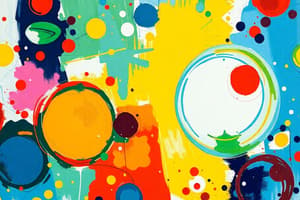Podcast
Questions and Answers
What happens when excess ammonia is added to copper(II) salt precipitates?
What happens when excess ammonia is added to copper(II) salt precipitates?
- It precipitates copper hydroxide.
- It converts into a colorless solution.
- It results in the formation of a deep blue solution. (correct)
- It forms copper(I) salt.
How do solutions of metal 2+ ions interact with sodium carbonate?
How do solutions of metal 2+ ions interact with sodium carbonate?
- They do not react at all.
- They produce hydrogen gas.
- They form insoluble carbonates and water. (correct)
- They react to form soluble bicarbonates.
What is the result of metal 3+ ions reacting with sodium carbonate?
What is the result of metal 3+ ions reacting with sodium carbonate?
- They yield a colorless precipitate.
- They react to produce a salt, water, and carbon dioxide. (correct)
- They release oxygen gas.
- They form a basic salt.
What occurs when metal aqua ions react with concentrated hydrochloric acid?
What occurs when metal aqua ions react with concentrated hydrochloric acid?
Which statement about the reactions of metal ions with ammonia is accurate?
Which statement about the reactions of metal ions with ammonia is accurate?
Which metal aqua ions are known to form coloured precipitates?
Which metal aqua ions are known to form coloured precipitates?
What is the characteristic of the solutions formed by iron(II) and copper(II) ions?
What is the characteristic of the solutions formed by iron(II) and copper(II) ions?
What colour precipitate does aluminium form when reacted with sodium hydroxide?
What colour precipitate does aluminium form when reacted with sodium hydroxide?
Which metal ion is known to dissociate more and exhibit stronger acidic properties?
Which metal ion is known to dissociate more and exhibit stronger acidic properties?
What happens to aluminium salts in the presence of excess sodium hydroxide?
What happens to aluminium salts in the presence of excess sodium hydroxide?
Which property characterizes the reaction of metal ions with sodium hydroxide?
Which property characterizes the reaction of metal ions with sodium hydroxide?
How can one remember the formula of the precipitates formed by metal ions?
How can one remember the formula of the precipitates formed by metal ions?
What is the result of hydrolysis of metal ions in aqueous solution?
What is the result of hydrolysis of metal ions in aqueous solution?
Study Notes
Metal Aqua Ions in Aqueous Solution
- Metal ions in water are surrounded by water molecules, forming hydrated ions.
- Four key metal aqua ions are: iron(II), copper(II), iron(III), and aluminium.
- These ions form coloured precipitates when reacted with various reagents.
- The metal aqua ions act as acids due to their ability to donate protons.
Acidic Properties
- Metal ions forming 2+ ions, such as iron(II) and copper(II), are weaker acids than those forming 3+ ions, like iron(III) and aluminium.
- 3+ ions dissociate more, resulting in a stronger attraction to basic OH- ions.
Reactions with NaOH
- Metal aqua ions react with sodium hydroxide (NaOH) in a neutralisation reaction, forming a salt and water.
- Precipitates formed in these reactions have colours:
- Aluminium: white
- Iron(II): green
- Copper(II): blue
- Iron(III): brown
- The number of OH- ions in the precipitate's formula matches the charge on the metal ion.
Amphoteric Salts
- Aluminium salts are amphoteric, meaning they can act as both acids and bases.
- When excess NaOH is added to aluminium salts, the salt acts as an acid and is further hydrolysed.
Reactions with Ammonia (NH3)
- Metal aqua ions react with aqueous ammonia (NH3), forming a salt and ammonium ions.
- Excess ammonia causes ligand substitution in the copper(II) precipitate, forming a deep blue solution.
Reactions with Na2CO3
- Metal 2+ ions react with sodium carbonate (Na2CO3) as acids, producing insoluble carbonates and water.
- 3+ metal ions react more strongly as acids, producing salt, water, and carbon dioxide.
Reactions with Chloride Ions (Cl-)
- All metal aqua ions undergo ligand substitution in concentrated hydrochloric acid, forming tetrahedral ions with four Cl- ligands.
Studying That Suits You
Use AI to generate personalized quizzes and flashcards to suit your learning preferences.
Related Documents
Description
Test your knowledge on metal aqua ions and their properties in aqueous solutions. This quiz covers the acidic behavior of metal ions, their reactions with sodium hydroxide, and the colors of the precipitates formed. Delve into the fascinating interactions between metal ions and water!




